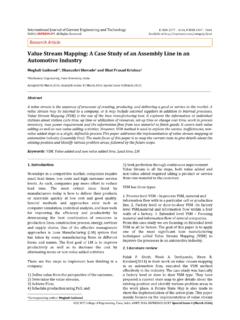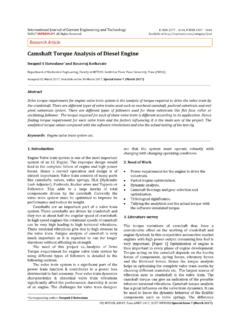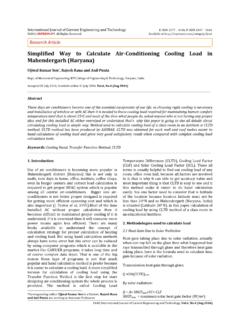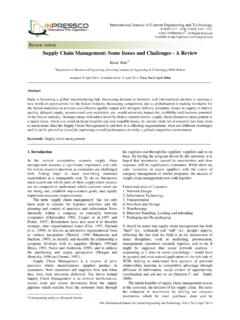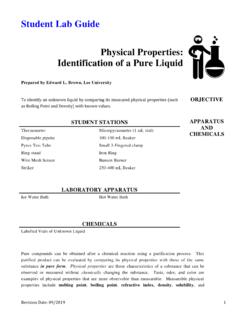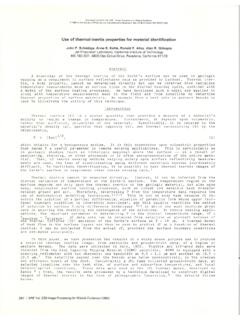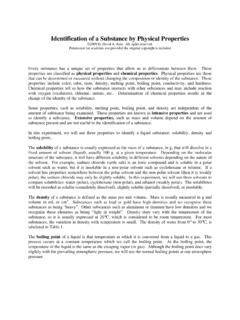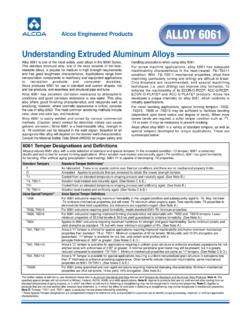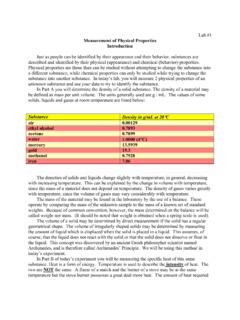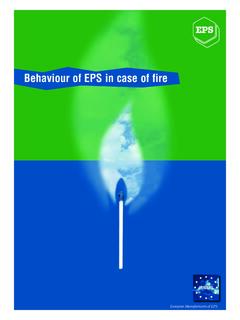Transcription of Analysis of Mechanical Properties of En19 Steel and …
1 DOI: 162 | International Conference on Advances in Mechanical Sciences 2014 Research Article International Journal of Current Engineering and Technology E-ISSN 2277 4106, P-ISSN 2347 - 5161 2014 INPRESSCO , All Rights Reserved Available at Analysis of Mechanical Properties of en19 Steel and En41b Steel Used In Diesel Engine Camshaft Diwakar *, C. Bhagyanathan and J. David Rathnaraj Manufacturing Engineering Department, Sri Ramakrishna Engineering College, Coimbatore Accepted 10 January 2014, Available online 01 February 2014, Special Issue-2, (February 2014) Abstract Camshaft is one of the key parts or components in the engines of automobile and other vehicles. Due to the cyclic impact loading on the contacting surfaces of the cam and the follower, it often gives rise to premature wear of cam profile and affects a routine run of the valve gear such as the rotational speed, valve displacement and the torque.
2 The objective of this work was to study experimentally the residual stresses at the surface layer of induction hardened cylindrical specimens. The diesel engine camshafts are generally made by en19 Steel material. However, en19 Steel material has low wear resistance and its service life is shorter. ReplacingEN19 Steel with EN41B Steel . The results obtained from hardness test indicated that the hardness of the Nitride Steel EN 41B is 31% higher than en19 Steel before induction hardening and the hardness of the Nitride Steel EN41B is 45% higher than en19 Steel after induction hardening. Impact test indicated that the toughness of Nitride Steel EN41B is 38% higher than en19 Steel . Keywords: ANSYS, Induction Hardening, Pro/E model, Impact Test, Hardness Test. 1. Introduction 1 The camshaft is an apparatus often used in piston engines to operate poppet valves.
3 It consists of a cylindrical rod running the length of the cylinder bank with a number of oblong lobes or cams protruding from it, one for each valve. The cams force the valves open by pressing on the valve, or on some intermediate mechanism, as they rotate the relationship between the rotation of the camshaft and the rotation of the crankshaft is of critical importance. Since the valves control the flow of air/fuel mixture intake and exhaust gases, they must be opened and closed at the appropriate time during the stroke of the piston. For this reason, the camshaft is connected to the crankshaft either directly, via a gear mechanism, or indirectly via a belt or chain called a timing belt or timing chain. Duration can often be confusing because manufacturers may select any lift point to advertise a Camshaft s duration and sometimes will manipulate these numbers.
4 The power and idle characteristics of a camshaft rated at .006" will be much different than one rated the same at .002". Whenever duration is quoted, be sure to note the lift at which it is given. In general, duration determines how many crankshaft degrees a camshaft maintains more than a given tappet lifts. Depending on the location of the camshaft, the cams operate the valves either directly or through a linkage of pushrods and rockers. Direct operation involves a simpler mechanism and leads to fewer failures, but requires the camshaft to be positioned at the top of the cylinders. The rockers or cam followers sometimes *Corresponding author: Diwakar incorporate a mechanism to adjust and set the valve play through manual adjustment, but most modern auto engines have hydraulic lifters, eliminating the need to adjust the valve lash at regular intervals as the valve train wears, and in particular the valves and valve seats in the combustion chamber.
5 Classification of cams The cam, as a means of producing a given type of motion, is simple and reasonable to design, provided the simple principles are understood. Another advantage is that, generally, a cam can easily be changed or modified to allow a change of motion, without interfering with the remainder of the mechanism. Cam followers There are three types of cam followers, and since the type of follower influences the profile of the cam it is worthwhile considering the advantages and disadvantages of each type. The three types are the knife-edge, the roller follower and the flatfoot or mushroom follower. Diesel engine Highly fuel efficient, Greaves lightweight diesel engines are ideal for automotive applications like 2-wheelers, 3-wheelers, mini cars etc.
6 These engines with high power-to-weight ratio are also used extensively for portable agricultural pump sets, gensets, small boats, construction Diwakar et al International Journal of Current Engineering and Technology, Special Issue-2 (Feb 2014) 163 | International Conference on Advances in Mechanical Sciences 2014 equipment and host of other applications. Available in a range of 4-10 HP models, Greaves light diesel engines are widely used in Defense applications. These engines are manufactured at ISO 9001 certified Units in Aurangabad and Ranipet. Table 1 Engine specifications Bore 78 mm Stroke 68mm Displacement 325cm3 Compression ratio 18:01 Rpm 1500 - 1800 Max.
7 Torque ( ) 205220 Lub oil consumption 13gm/hr Capacity of fuel tank liter Capacity of oil sump 1 liter Dry weight 38kg 2. Problem identification The diesel engine camshaft The diesel engine camshafts are generally made by en19 Steel material. However, en19 Steel material has low wear resistance and its service life is shorter. In camshaft, particularly lobes suffer wear over time to a point where valve lift is reduced and engine performance is degraded. Also it necessitates frequent replacement leading to loss of time and money. Figure 1 Failure of the Camshaft Table 2 Chemical Composition of en19 Steel Chemical Composition Fe C Si Mn P S Cr Mo Ni Al Nitride Steel EN 41B To overcome above said, problem in camshaft an alternate material namely, Nitrite Steel EN41B has been identified, chosen and analyzed for its performance.
8 Table 3 Chemical Composition of Nitride Steel EN 41B Chemical Composite AL C Cr Fe Mn Mo Si Application of Nitride Steel EN 41B Die casting dies Gears Plungers and cylinders Abrasive wheels Plastic mould parts Spindles Extrusion screws and barrels Case hardening The case hardening (or) surface hardening is the process of hardening the surface of metal, often low carbon Steel , by infusing element into the material surface, forming a thin layer of a harder alloy. Case Hardening for Camshaft Depending on the application and economical reasons there are several materials for the manufacturing of cam and camshafts that require surface (or) case hardening. In this project, the two materials Nitride Steel EN41B and en19 Steel were hardened by induction hardening method for case depth and the increment in the hardness were compared.
9 Induction Hardening Figure 2 Induction Hardening Diwakar et al International Journal of Current Engineering and Technology, Special Issue-2 (Feb 2014) 164 | International Conference on Advances in Mechanical Sciences 2014 It is a form of heat treatment in which a metal part is heated by induction heating and then quenched, increasing the hardness and brittleness of the part. Induction hardening is used to selectively harden areas of a part or assembly without affecting the Properties of the part as a whole. Principal methods Single shot hardening Traverse hardening Purpose of Induction Hardening It gives higher surface hardness of the Steel The deformation produced is very small.
10 The depth of heated surface can be easily controlled. 3. Specimen preparation Table 4 Induction Hardening TREATMENT CONDUCTED BEST heat TREATMENT,COIMBATORE identification EN19steel and Nitride Steel EN 41B Specimen Case depth Power 30KW Spindle speed 2000mm/min Table 5 Depth of Case Hardening MATERIAL DEPTH OF CASE HARDENING en19 Steel Nitride EN41B Steel Table 6 Cylindrical Surface Grinding Cutting MATERIAL BEFORE SUFACE GRINDING AFTER SURFACE GRINDING en19 Steel 10mm Nitride EN41B Steel 10mm Specimen preparation for Toughness test Table 7 Material Sizes MATERIAL DIAMETER LENGTH en19 Steel 16mm 300mm Nitride EN41B Steel 20mm 300mm Table8 Milling, Cutting and Notching OPERATION en19 Steel NITRITE En 41B Steel Milling 6mm 10mm Cutting 55mm 55mm Notching 2mm 2mm Table 9 Specimens for Toughness Test MATERIAL LENGHT WIDTH BREATH en19 Steel 55mm 10mm 10mm Nitride EN41B Steel 55mm 10mm 10mm Figure 3 Specimens for impact test 4.
